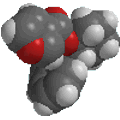| Chapter 1: Structure Determines Properties |
| Chapter 1: Structure Determines Properties |
Simplistically, chemistry is about the interaction of molecules with other molecules.
There are two ways in which this octet can be achieved, either
Most bonds in organic molecules are covalent bonds but common exception are the bonds to metal atoms (where the metal atoms should be treated as ions).
You should be able to identify whether an ionic or covalent bond is present between atoms.
If you think you already can then try some
questions.
If you are unsure, then you need to review
the types of bonding in more detail.
It is important to note that the electron
distribution within a covalent
bond is not always symmetrical.
This is to be expected if the atoms are of different electronegativities.
If the electron distribution is not symmetrical, then the bond will
be polar and a bond dipole exists.
Now try some questions. If you are having difficulty then you need to review bond polarity.
 |
© Dr. Ian Hunt, Department of Chemistry, University of Calgary |  |